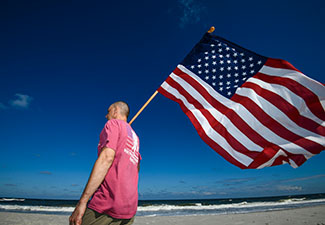Beards: Gas-Mask Obstruction, Camouflage, and Cultural Icon

When we hear “special forces,” many of us picture a bearded, tough, muscular physique suggesting a diet of nothing but corn since the age of 5. And for fair reason — Hollywood films over the last decade, including 13 Hours, Zero Dark Thirty, American Sniper, Lone Survivor, and Seal Team, have reinforced this image of special forces.
The heroes of those films and shows feature facial hair ranging from “I just woke up” to “I’ve been living in the woods for a year.” Like many Hollywood portrayals, that depiction has a changing measurement of truth, but it has nevertheless helped normalize beards and bring them back into the mainstream.
Both in the military and civilian life, these scraggly (or meticulously groomed) face fluffs are particularly present in November, known as “No-Shave November” or “Movember.” What is the origin of this mainstream cultural phenomenon, and how does it fit into military culture?
Where No-Shave November Comes From
For some, it’s a simple way to justify not shaving for an entire month. For others, it’s a test of manly prowess to see who can grow the biggest beard in a month.
However, the month-long tradition also has roots in supporting worthy causes and raising awareness.
It began with two men in Australia who took the month to grow out their facial hair, later turning their beard-growing into a fundraising effort for the Prostate Cancer Foundation of Australia. Movember took off as a global trend, hitting the U.S. in 2007 when The Movember Foundation partnered with the Prostate Cancer Foundation.
For some service members, however, No-Shave November isn’t feasible. For those in the Special Forces, every day is No-Shave November.
Shaving for Safety
Clean-shaven – that’s pretty much the default for military servicemen. Gas masks are the most common reason military members can’t grow beards. When a gas mask is placed on a person’s face, it needs to form a perfect seal to keep out toxins, radiation, smoke, or other environmental hazards. But hairs on the face create tiny gaps in that seal – small enough to barely notice, but big enough to be deadly.
However, the military's debate has shifted toward allowing beard growth. In 2017, the U.S. Army revised regulations allowing beards and headdresses on religious grounds. While regulations are revised, the biggest argument against beards is changing too, as companies that produce military gas masks have begun testing beard-friendly versions of the gear.
Potential changes may soon allow certain facial hair for the first time. For example, the draft of the 2025 National Defense Authorization Act by the House Armed Forces Committee recently added an amendment to require the Air Force to study the impact of allowing certain Space Force and Air Force members to grow beards.
But for some in the military, beards can provide a different form of safety – they can act as camouflage.
The Importance of Beards in Combat
The special forces’ “operator beards” serve more purpose than simply setting them apart from other military service members.
Beards, longer hair, and other popular styles allow them to fit into communities as civilians.
In the world of special forces, blending in is crucial for operators, increasing their chances of navigating complex situations unnoticed, gathering vital intelligence, and building rapport with key contacts.
To learn about something other than beards, like how WWP’s programs and services empower, employ, and engage wounded warriors and their families, click here.
Contact: Kaitlyn McCue, Public Relations, kmccue@woundedwarriorproject.org, 904.870.1964
About Wounded Warrior Project
Since 2003, Wounded Warrior Project® (WWP) has been meeting the growing needs of warriors, their families, and caregivers — helping them achieve their highest ambition. Learn more about Wounded Warrior Project.


